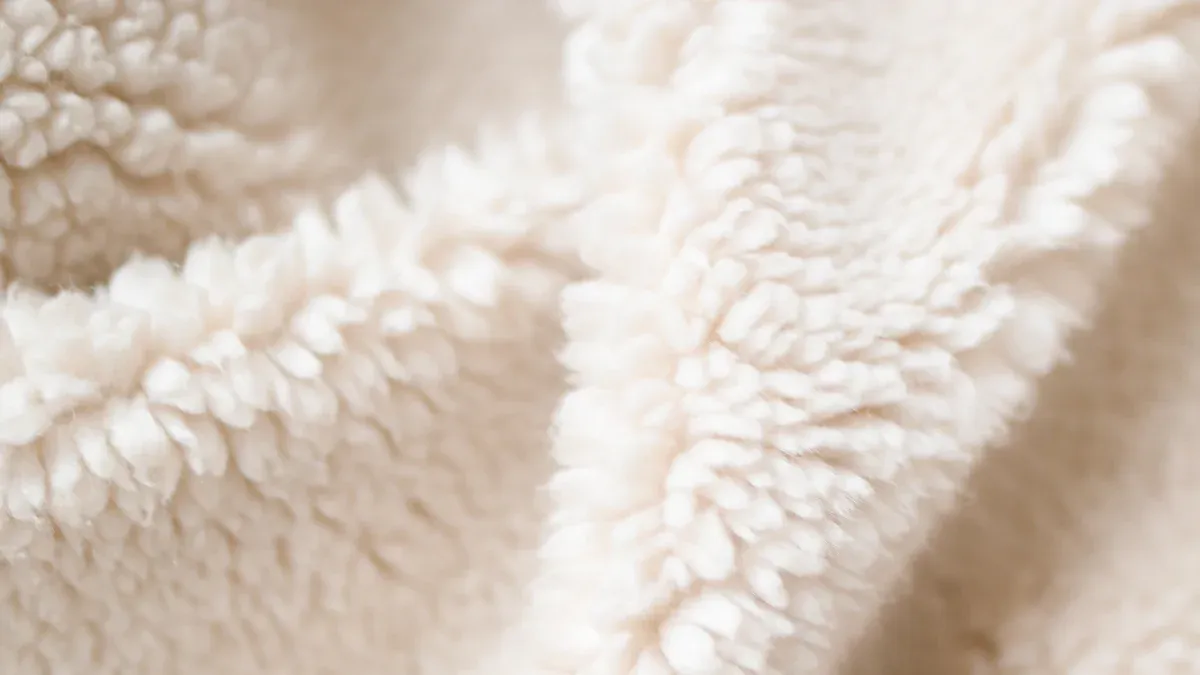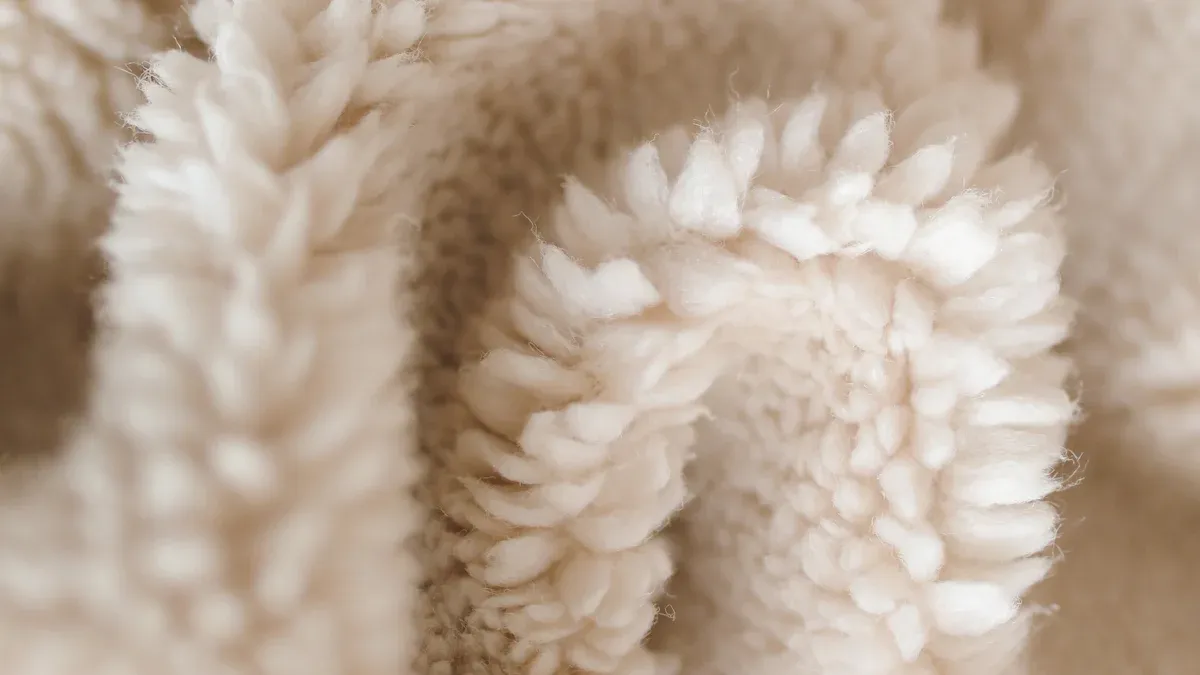
Sherpa knit fabric feels soft and fluffy, like wool. It has two different sides. One side has a curly pile. The other side is smooth and knitted. Most sherpa fabric uses about 70% polyester and 30% acrylic. This makes it light and strong. Many sherpa fabrics are made from faux sherpa material. Real sherpa material is not common. People like sherpa for cold-weather clothes. It keeps you warm and comfortable. Lately, sherpa and faux sherpa are very popular. They look and feel cozy. Real sherpa is special and seen as a premium choice.
Key Takeaways
Sherpa knit fabric feels soft and fluffy, offering warmth like wool but is lighter and easy to care for.
The fabric has two sides: a curly, wool-like pile for insulation and a smooth knitted side for comfort.
Sherpa is great for winter clothes, blankets, and accessories because it keeps you warm without heavy layers.
To keep sherpa soft and lasting long, wash it gently in cold water, avoid high heat, and store it dry and loose.
Compared to fleece, sherpa looks fluffier and warmer, making it ideal for cozy wear and home textiles.
Sherpa Knit Fabric Features

Softness and Texture
When you touch sherpa, you feel how soft it is. The fabric has two sides. One side is curly and feels like sheepskin. The other side is smooth and knitted. This makes sherpa knit fabric very comfortable. It feels gentle, almost like a cloud on your skin. Many people enjoy sherpa fabric because it is cozy. The polyester and acrylic fibers help make it soft. You get the comfort of wool, but it is lighter. These features make sherpa fabric great for anyone who wants soft clothes or home items.
Warmth and Insulation
Sherpa is known for keeping you warm. The curly side holds warm air close to your body. This helps you stay warm on cold days. Sherpa fabric blocks cold wind from getting in. You do not need to wear heavy clothes to feel warm. Sherpa knit fabric is light and warm, so people like it for winter clothes. You can wear jackets lined with sherpa or use sherpa blankets. The warmth works well inside or outside. You stay warm without feeling heavy.
Breathability
Sherpa keeps you warm, but it does not breathe as well as some fabrics. The bumpy surface holds heat and feels soft. This makes it comfy, even if you wear it for a long time. But sherpa fabric is less breathable than polar fleece. You may feel warmer, but it does not let heat and sweat out easily. This makes sherpa good for times when you want to stay warm, like sitting outside or taking a slow walk. For sports or hard work, sherpa might feel too hot because it traps heat.
Note:
Sherpa fabric keeps warm air close, so you stay cozy.
The soft, plush feel is nice for wearing a long time.
Sherpa does not let air through as well as some fabrics, so it is best when you want to stay warm.
Sherpa can feel bulky and may not be good if you need to cool off fast.
Durability
You can trust sherpa to last a long time. The polyester and acrylic fibers are strong and do not wear out fast. The fabric keeps its shape and softness after many washes. Sherpa fabric does not pill or mat easily. It stays soft and fluffy for a long time. Many people pick sherpa for things they use a lot because it stays cozy year after year.
Sherpa Knit Fabric Uses

Clothing and Outerwear
Sherpa is used a lot in clothes and jackets. It keeps you warm and feels soft. Many winter coats and sweaters have sherpa inside or outside. The fluffy side holds heat, so you stay cozy. Sherpa feels nice on your skin and looks stylish. You can wear sherpa-lined clothes for extra warmth. You do not need to wear heavy layers. Sherpa is also found in vests and hoodies. These are great for winter and outdoor use. When you pick sherpa, you get comfort and style.
Home Textiles
Sherpa adds warmth and a soft feel to your home. You see sherpa blankets and cushion covers in many rooms. Sherpa makes these items feel cozy and relaxing. Here are some ways sherpa helps your home textiles:
Makes your space feel soft and welcoming for relaxing or hanging out.
Gives strength, comfort, and warmth to your home items.
Has a fuzzy feel that makes things extra comfy.
Traps air with thick fibers, so it keeps you warm.
Stays soft and strong even after lots of use.
Has two sides, which helps block cold and wind.
Looks and feels like wool, making your home cozier.
Works as a vegan choice, dries fast, and pulls away moisture.
Sherpa made from synthetic fibers is easy to care for and lasts long. You can use sherpa on chairs or sofas for a soft touch. Many people like sherpa for home items because it is warm and cozy.
Accessories
Sherpa is used in many winter accessories. Sherpa hats, scarves, gloves, and boot liners keep you warm. Sherpa feels soft and fluffy, like real wool. People like sherpa for cozy clothes because it is warm and comfy.
Here is a table that shows how sherpa makes accessories strong and comfortable:
Feature | Contribution to Durability and Comfort |
|---|---|
Soft, fluffy texture | Gives warmth and insulation, so you feel comfortable in cold weather. |
Durability | Polyester fibers make sherpa last a long time. |
Moisture wicking | Stops sweat from making you feel damp. |
Cushioning | Adds padding, so boots and gloves do not rub. |
Production process | Knitting and brushing make sherpa thick and soft but still strong. |
Fabric type variations | Knitted sherpa is quick to make, while woven sherpa can be warmer and feel different. |
Sherpa accessories last through many winters. They stay soft and keep you warm. This makes them a good choice for cold days.
Outdoor Gear
Sherpa is great for outdoor gear because it is warm but not heavy. You find sherpa in sleeping bags, camping blankets, and some jackets. Sherpa gear keeps you comfortable when you camp or go outside.
Sherpa gives lots of warmth but stays light, so you do not feel heavy.
The fluffy side holds air close to your body for insulation.
Sherpa lets air move and pulls sweat away, so you stay dry.
The fabric is animal-friendly and safe for sensitive skin.
Sherpa is strong and easy to wash in a machine.
It does not soak up water like wool, so it stays light and dry.
Sherpa blankets are thick and soft, giving you warmth outside.
These blankets can be heavier and not as easy to pack, but they are very cozy when you need warmth.
Sherpa fleece, a kind of sherpa knit fabric, keeps you warm even if it gets wet. It is light, dries fast, and is easy to care for. You can trust sherpa for outdoor gear that is warm, comfy, and simple to use.
Sherpa vs Fleece
Texture and Feel
When you compare sherpa and fleece, you notice a clear difference in how they look and feel. Sherpa has a thick, fluffy surface that looks very warm and cozy. It often reminds you of imitation cashmere or lambswool. The surface appears plump and full, which makes sherpa stand out in winter fashion. However, when you touch sherpa, you may find it feels a bit harder and rougher than fleece. Fleece, especially coral fleece, has finer and more delicate fibers. This gives fleece a smoother and softer touch. Textile experts say sherpa looks softer than it feels, while fleece feels softer than it looks. If you want a fabric that feels gentle on your skin, fleece may be the better choice for cozy apparel. The difference between sherpa and fleece becomes clear when you care about tactile comfort.
Tip: If you want a fabric that looks extra plush, choose sherpa. If you want a fabric that feels extra soft, try fleece.
Warmth and Weight
Both sherpa and fleece keep you warm, but they do it in different ways. Sherpa traps heat well because of its fluffy pile. You get great insulation without heavy layers. Fleece also provides warmth, but its weight and thickness can change a lot. Some fleece fabrics are lightweight, while others are thick and heavy. Sherpa usually feels lighter and less bulky than heavyweight fleece. You can see the difference between sherpa and fleece in this table:
Aspect | Sherpa | Fleece |
|---|---|---|
Weight | Lighter, less thick | Can be heavier and thicker |
Warmth | Very warm, traps heat | Warm, depends on thickness |
Softness | Plush, cozy | Varies, often very soft |
Sherpa gives you lightweight and warmth, which is perfect for cold-weather clothing and winter wear.
Best Uses
You can use sherpa and fleece for many of the same things, but each fabric has its strengths. Sherpa works best for extreme cold, winter coats, sherpa blankets, and cold-weather accessories. It shines in winter fashion and home goods like throws and pillows. Fleece is more versatile. You find it in jackets, hoodies, pants, and even baby clothes. Fleece works well for activewear because it stretches and dries fast. If you spend time outdoors, fleece gives you breathability and moisture control. Sherpa is better for warmth and comfort when you want to relax or stay cozy inside. The difference between sherpa and fleece helps you pick the right fabric for your needs.
Choose sherpa for:
Extra warmth in winter coats and linings
Home textiles like sherpa blankets and pillows
Cold-weather accessories and cozy apparel
Activewear and outdoor gear
Everyday jackets and sweaters
Clothing for kids and babies
Note: Industry professionals look at warmth, comfort, durability, and cost when they decide between sherpa and fleece. Think about how you will use the fabric before you choose.
Sherpa Fabric Care
Washing Tips
You want your sherpa knit fabric to stay soft and fluffy. The right washing method helps keep your sherpa blankets and cozy apparel looking new. Always check the care label first. Most sherpa fabric made of polyester or acrylic needs gentle care. Here are some tips to follow:
Shake out loose dirt and pet hair before washing.
Wash sherpa fabric separately from other items, especially those with Velcro or rough textures.
Use cold water and a mild detergent. Hot water can damage the insulating properties and softness.
Choose a gentle or delicate cycle on your washing machine. If you hand wash, use cool to lukewarm water and gently massage the fabric.
Avoid bleach and fabric softeners. These can coat the fibers and reduce softness.
Limit the spin speed to prevent stretching.
Air dry flat in a well-ventilated area, or tumble dry on low heat or ‘fluff’ setting. High heat can shrink or melt synthetic fibers.
Never iron sherpa fabric. Heat can ruin the plush texture.
Tip: After drying, shake or brush your sherpa blankets to keep them fluffy and soft.
Preventing Shedding and Pilling
You can keep your sherpa fabric used to make winter coats and cold-weather accessories looking great by preventing shedding and pilling. Follow these steps:
Turn your apparel inside out before washing to protect the surface.
Use liquid detergent without bleach or fabric softener.
Wash on a gentle cycle or hand wash to reduce friction.
Avoid washing with rough items like jeans or bags.
Air dry or lay flat instead of using high heat in the dryer.
Use a lint roller to remove loose fibers after each wash.
Keep sherpa away from rough surfaces and jewelry to prevent pilling.
These steps help maintain the characteristics of sherpa fabric, so your winter wear and outdoor gear last longer.
Storage
Proper storage keeps your sherpa knit fabric in top shape. Always store sherpa blankets, cold-weather clothing, and outdoor clothing in a cool, dry place. Make sure the fabric is completely dry before folding. Avoid compressing sherpa fabric too much, as this can flatten the fluffy pile. Store items in a bin or on a shelf, away from direct sunlight and moisture. This helps preserve the lightweight and warmth you love in sherpa and prevents fading or damage.
Note: Good storage habits extend the life of both real sherpa material and faux sherpa material, so your winter fashion stays cozy year after year.
You get many benefits when you choose sherpa knit fabric.
It feels soft and fuzzy, much like sheep fleece.
The fabric keeps you warm with excellent insulating properties.
Sherpa fabric stays strong and soft after many washes.
You can use it for winter coats, sherpa blankets, cold-weather clothing, and outdoor gear.
Sherpa fabric made of synthetic fibers is easy to care for and cost-effective.
Sherpa brings comfort and style to winter fashion. Take care of your sherpa fabric used to make winter wear, and you will enjoy its lightweight and warmth for years.
FAQ
What makes sherpa knit fabric different from regular fleece?
You will notice the difference between sherpa and fleece in the texture. Sherpa knit fabric has a curly, wool-like pile. Fleece feels smoother and softer. Sherpa gives you more warmth and a plush look, which works well for winter fashion and cozy apparel.
Can you use sherpa fabric for outdoor gear?
Yes, you can use sherpa fabric for outdoor gear. It offers lightweight and warmth, making it great for camping blankets, jackets, and other outdoor clothing. Sherpa fabric used to make outdoor gear keeps you comfortable in cold weather.
Is sherpa fabric made of real wool?
Most sherpa fabric made of polyester and acrylic does not use real wool. Real sherpa material is rare and costs more. Faux sherpa material gives you the same soft feel and insulating properties as real wool, but it is easier to care for.
How do you keep sherpa blankets soft after washing?
You should wash sherpa blankets in cold water with mild detergent. Air dry them or use a low heat setting. This helps keep the fluffy texture and insulating properties. Avoid high heat and fabric softeners to protect the characteristics of sherpa fabric.
What are the best uses for sherpa in winter wear?
You can use sherpa in winter coats, cold-weather clothing, and cold-weather accessories. Sherpa knit fabric adds warmth and comfort to your apparel. It works well as a lining or outer layer in winter wear, giving you both style and function.









